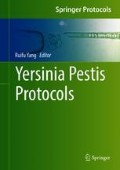Abstract
Type III secretion systems (T3SSs) are finely tuned molecular machines that are required for the virulence of many Gram-negative bacteria. Both the transcription and secretion of the Yersinia pestis Ysc T3SS are highly activated at 37 °C when the bacteria are cultured in low-calcium medium in vitro (Cornelis GR: Nat Rev Microbiol 4(11):811–825, 2006). The Y. pestis Ysc T3SS has evolved a sophisticated regulatory mechanism to control the assembly of the secretion apparatus and the secretion of substrates. Once the transcription and secretion of the T3SS have been triggered, the secretion apparatus, called the injectisome, is assembled such that it extends from the bacterial surface. The needle of the Yersinia injectisome has a helical structure that consists of a few hundred copies of the YscF protein (Hoiczyk E, Blobel G: Proc Natl Acad Sci USA 98(8):4669–4674, 2001). In the presence of the cross-linker bis(sulfosuccinimidyl)suberate, bacterial surface-exposed YscF molecules that constitute the needle structure can be cross-linked via a covalent bond to form ladders of multimers, which can be evidenced after separation by sodium dodecyl sulfate–polyacrylamide gel electrophoresis and immunoblotting detection using a specific anti-YscF antibody (Wood SE et al: J Bacteriol 190(12):4252–4262, 2008). Thus, the presence of the YscF multimers indicates that the tested bacterial strain can assemble the needle. This chapter describes an immunoblotting detection method for analyzing the formation of the YscF needle of Yersinia strains expressing the Ysc T3SS, which can be used to analyze the impacts of different T3SS components on YscF needle formation.
Access this chapter
Tax calculation will be finalised at checkout
Purchases are for personal use only
References
Cornelis GR (2006) The type III secretion injectisome. Nat Rev Microbiol 4(11):811–825
Hoiczyk E, Blobel G (2001) Polymerization of a single protein of the pathogen Yersinia enterocolitica into needles punctures eukaryotic cells. Proc Natl Acad Sci U S A 98(8):4669–4674
Wood SE, Jin J, Lloyd SA (2008) YscP and YscU switch the substrate specificity of the Yersinia type III secretion system by regulating export of the inner rod protein YscI. J Bacteriol 190(12):4252–4262
Burghout P, van Boxtel R, Van Gelder P, Ringler P, Muller SA, Tommassen J, Koster M (2004) Structure and electrophysiological properties of the YscC secretin from the type III secretion system of Yersinia enterocolitica. J Bacteriol 186(14):4645–4654
Diepold A, Kudryashev M, Delalez NJ, Berry RM, Armitage JP (2015) Composition, formation, and regulation of the cytosolic c-ring, a dynamic component of the type III secretion injectisome. PLoS Biol 13(1):e1002039
Kimbrough TG, Miller SI (2000) Contribution of Salmonella typhimurium type III secretion components to needle complex formation. Proc Natl Acad Sci U S A 97(20):11008–11013
Diepold A, Wiesand U, Cornelis GR (2011) The assembly of the export apparatus (YscR,S,T,U,V) of the Yersinia type III secretion apparatus occurs independently of other structural components and involves the formation of an YscV oligomer. Mol Microbiol 82(2):502–514
Blaylock B, Riordan KE, Missiakas DM, Schneewind O (2006) Characterization of the Yersinia enterocolitica type III secretion ATPase YscN and its regulator, Yscl. J Bacteriol 188(10):3525–3534
Montagner C, Arquint C, Cornelis GR (2011) Translocators YopB and YopD from Yersinia enterocolitica form a multimeric integral membrane complex in eukaryotic cell membranes. J Bacteriol 193(24):6923–6928
Mota LJ (2006) Type III secretion gets an LcrV tip. Trends Microbiol 14(5):197–200
Torruellas J, Jackson MW, Pennock JW, Plano GV (2005) The Yersinia pestis type III secretion needle plays a role in the regulation of Yop secretion. Mol Microbiol 57(6):1719–1733
Du Z, Tan Y, Yang H, Qiu J, Qin L, Wang T, Liu H, Bi Y, Song Y, Guo Z et al (2009) Gene expression profiling of Yersinia pestis with deletion of lcrG, a known negative regulator for Yop secretion of type III secretion system. Int J Med Microbiol 299(5):355–366
Author information
Authors and Affiliations
Editor information
Editors and Affiliations
Rights and permissions
Copyright information
© 2018 Springer Nature Singapore Pte Ltd.
About this protocol
Cite this protocol
Cao, S., Du, Z. (2018). Detection of Type III Secretion System Needle Assembly in Yersinia pestis by Cross-Linking YscF. In: Yang, R. (eds) Yersinia Pestis Protocols. Springer Protocols Handbooks. Springer, Singapore. https://doi.org/10.1007/978-981-10-7947-4_16
Download citation
DOI: https://doi.org/10.1007/978-981-10-7947-4_16
Published:
Publisher Name: Springer, Singapore
Print ISBN: 978-981-10-7946-7
Online ISBN: 978-981-10-7947-4
eBook Packages: Springer Protocols

